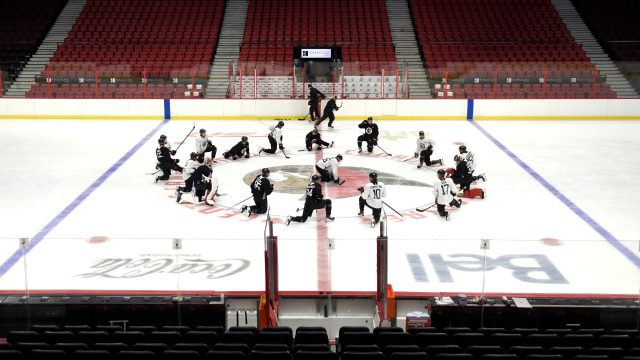MANALAPAN, Fla. — Do yourself a favour and open up CapFriendly.com’s homepage. Now skim straight down the pike, where it shows that 16 of 32 NHL teams have players designated long-term injury reserve and that each one of them is operating within the legal boundaries of the collective bargaining agreement, despite all being over the cap.
If you open up the NHL standings page on Sportsnet.ca, you’ll also notice that 10 of those 16 teams are in playoff spots and that another three are right on the bubble, fighting tooth and nail for a chance to make it.
Now, ask yourself: Do you think there is a genuine appetite among the majority of the league’s general managers to close the LTIR loophole that enables them to exceed the salary cap?
Given that this is written into the CBA, they couldn’t do it—even if they wanted to—without getting sign-off from the players. And we can’t see the players being too interested in giving that sign-off without some major concession being made by the league for them to do so.
But we digress.
While a few general managers sitting around the table for Tuesday’s three-hour meeting might have voiced their displeasure in seeing Nikita Kucherov bragging about the Tampa Bay Lightning being $18 million over the cap and winning the 2021 Stanley Cup, there’s no real desire to do away with the LTIR mechanisms.
The subject wasn’t even broached during the seven hours GMs spent together for Monday’s meeting, and it only took up about 30 minutes of Tuesday’s meeting.
“We all get sometimes focused in on recency bias,” said Calgary Flames GM Brad Treliving. “The reality is we’ve had a cap for 17 years and if there has been a grey area of it, it’s been maybe once or twice.
“Now, is there validity to say that we get to the playoffs and we’ve got a cap of $81.5 million and fundamentally that means we should only be able to dress $81.5 million in the playoffs? Sure, that makes sense. I think you’ve gotta go back and study it. I think in areas where you’ve come back and said there’s been abuses of LTI, really, what have those been?
“And the league does a very good job; you can’t just put somebody on LTI and add to your cap without the league going through that with a fine-tooth comb. There’s been legitimate injuries. The way the system’s set up, you can do certain things. I don’t necessary look at it as abusive. Are there areas that need to be tightened up? Maybe. But the sentiment in the room there wasn’t that it’s fundamentally broken.”
That Tampa became the poster child for seemingly abusing the system, with Kucherov missing all of last season post-hip surgery and then appearing in Game 1 of the playoffs, is obviously strictly because the Lightning won the Cup. Nobody said boo about the Montreal Canadiens being well into LTI spending while making it to the 2021 Final.
And the Lightning and Canadiens were two of 11 teams that made last year’s playoffs and exceeded the cap through LTI.
Lightning GM Julien BriseBois noticed.
“If we hadn’t won the Cup last season, perhaps we wouldn’t be the poster child,” he said. “But I’d rather win the Stanley Cup and be the poster child anyway, knowing that these situations have happened in the past. In 2015, we played against the Chicago Blackhawks in the Final and they had the example of Patrick Kane at the time and won the Cup. The situation we had last year with Kucherov—there’s 32 teams and it happens; there are many teams in LTI, so it’s not a question of teams purposely trying to take advantage of LTI. It’s more of a function of the salary cap not going up and clubs already having financial commitments to players that have to be respected, and that puts enormous pressure on everyone.
“It wasn’t that long ago that we were building our teams while keeping a cushion to call players up, but none of us are able to do that anymore. We’re no different than anybody else when you look at the cap for all the other teams. Most teams have had to go above the cap at one point or another this season.”
Even with the salary cap rising by $1 million next season, long-term injuries will continue to affect many teams and likely force them to use LTIR as a tool to remain competitive.
Commissioner Gary Bettman doesn’t have a problem with that.
He didn’t have a problem with the Lightning’s use of LTIR last year, and he said on Tuesday that he has no problem with how the Vegas Golden Knights are using it this year.
Yes, Vegas has three players with salaries designated to LTIR. And yes, it appears quite convenient that Mark Stone and his $9.5-million salary are there and have been since before the Golden Knights traded for Jack Eichel and his $10-million salary.
But we’re pretty sure the Golden Knights would rather have Stone in their lineup, as they’re dealing with injuries to Max Pacioretty, Robin Lehner, Reilly Smith and Bradyen McNabb, and barely clinging to the final playoff spot in the Western Conference.
And it’s not as if they—or any other team—are lying about the injuries.
“It’s no secret that around every trade deadline we reach out to the clubs and understand their injury situation and get a sense of projected dates of return,” deputy commissioner Bill Daly said on Tuesday. “And whenever the projected date of return and LTIR is being used and the projected date of return is around the playoffs, we look into it. We deal with the clubs, we get their medical records, we employ an independent medical expert and we make sure the (details are accurate regarding) the injury. We’ve never had any issues that stemmed from that. But it’s a thorough process.”
It won’t change.
Same way the LTIR mechanism isn’t likely to change.
At least not imminently.
“It’s not anything that’s going to get addressed as a front-burner issue anytime soon,” said Bettman.
NHL won’t stand in the way of teams drafting Russian prospects
Not that we expected Bettman or Daly to say otherwise, but we wanted to get the league’s official word on how it’ll treat the drafting of Russian prospects while the country’s invasion of Ukraine remains in full swing.
“Look, it’s an evolving situation,” said Daly. “The world might look different in July than it does today, so let’s see where we are then. But it’s not our current intention to have any restriction on Russian players being drafted.”
Whether or not teams will be willing to select any of the 15 Russian players ranked by NHL central scouting to be among the top-50 European skaters is another story. Whether they’d take the three Russian goaltenders ranked in the top 10 is up for debate.
Taking any players from Russia is an issue that’s going to have to be thoroughly contemplated by each GM and their respective staff, and that’s not due to any political leanings.
As Treliving intimated, you can draft Russian players, and he doesn’t think anyone should be prohibited from doing so.
But Treliving also said, “The bigger issue is your ability to access those players—and that’s from the bricks and mortars of visas and all those types of things. That’s something that you have to consider.”
As we get closer and closer to July, this will become an important internal debate for every team. It will be fascinating to see how it eventually plays out in Montreal, the host city for the 2022 Draft.
NHL working on 2024 World Cup of Hockey
Daly said a preliminary plan for the 2024 World Cup of Hockey was tabled for the GMs Tuesday, but that it’s fluid and needs to be accelerated to hammer out key details to bring the event to life.
We don’t know when exactly it will happen, even if we do know the target is 2024. We don’t know where it’ll happen, either. And the format of the tournament is being contemplated, according to Daly.
He did share that, this time around, it’s only going to be a country-versus-country event.
Rest in peace, Team North America Under-23 and Team Europe. We hardly knew ye.
Summer World Junior will be missing key players
We didn’t get to this subject with several GMs, but we did speak to the one who oversees the player who was Canada’s captain at the interrupted tournament from this past winter.
We asked Montreal Canadiens GM Kent Hughes how he’d feel about permitting Kaiden Guhle to play at the World Juniors in mid-August, just before coming to NHL training camp.
“I think in Guhle’s case, I talked to him in Edmonton after his game (on March 4), and it was pretty shocking the amount of hockey he’s had to play and will have to play. The Memorial Cup is coming up so late (end of June) and there’s very little recovery time (if the Oil Kings make it). It’s almost like it could be 18 months of straight hockey.
“It’s not optimal, certainly. If you’re asking if, as an organization, we have a position or that we would recommend that he not participate, we haven’t had that conversation. It’s not that simple if the player wants to go represent his country. We’ll tackle that at a later point, and he may have his own thoughts about it.”
Should Guhle adamantly want to participate, we asked Hughes if he could see the tournament as a springboard into training camp for the player.
“It could be,” he said. “It’s not so much training camp that we’re worried about, though. We’re worried about the development over the course of the year and just making sure that he doesn’t get run down and injured.”
Again, we didn’t broach this subject with too many GMs. But you have to think many of them have the same concerns.









